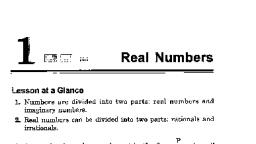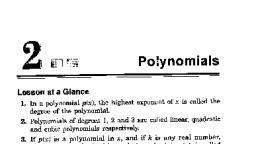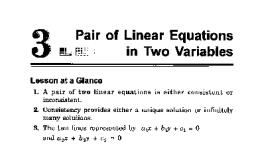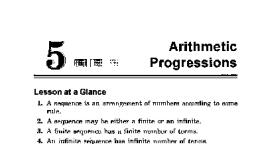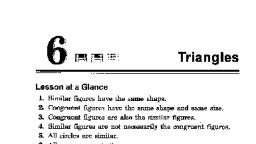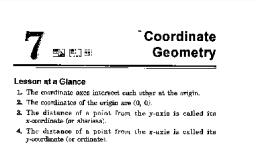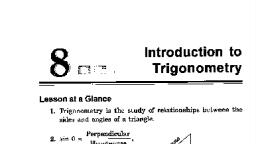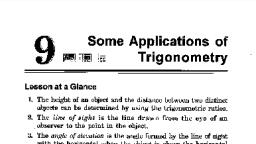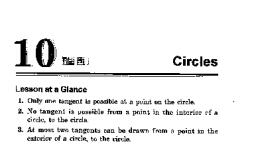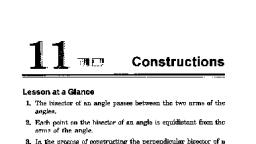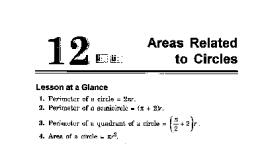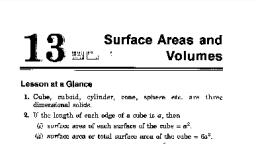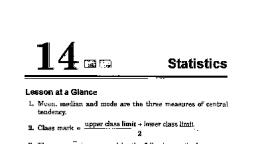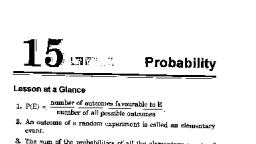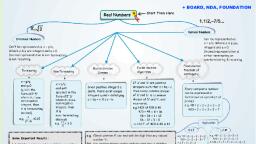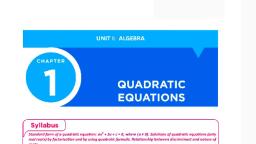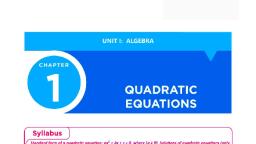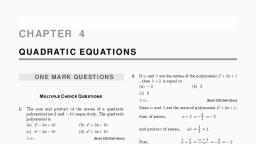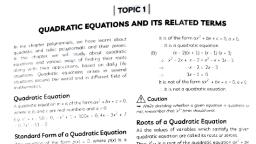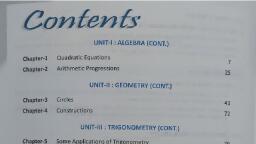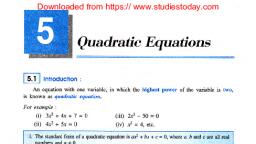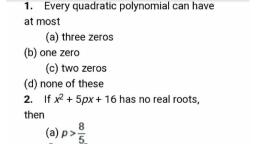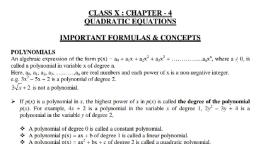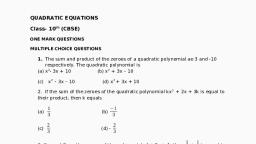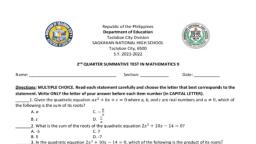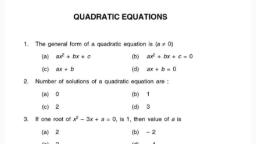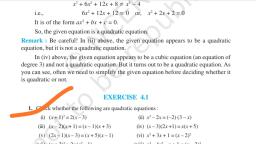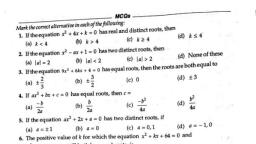Page 1 :
4 Quadratic, me Equations, , Lesson at a Glance, , 1. The standard form of a quadratic equation is, ax? +bx+c=0,a% 0., , 2. A quadratic equation has at most two roots., , 3. A real number « is said to be a root of the quadratic equation, ax? + bx +e = 0, ifac?+ba+e=0., , 4, If o and § are two roots of a quadratic equation, ax” + bx + ¢ = 0, then, , Sum of the roots = a + B = a2 and product of the roots, a, , =ap= ©., a, &. Discriminant of a quadratic equation ax? + bx +e = 0 is, given by, D = 8? - 4ac., @. The equation ax” + bx + ¢ = 0 has, (i) two distinct real roots, if b? - 4ec > 0, (éi) two equal real roots, if b? - 4ac = 0, (iii) no real roots, if b? — 4ac < 0., 7. The roots of a quadratic equation ax” + bx + ¢ = Oare given by, -b+ Jb? — 4ac, —, 8 A quadratic equation can also be solved by the method of, completing the square or by factorization., 9. In the method of factorization, we generally split the linear, (middle) term into two parts., 10. If a and B are the two roots of a quadratic equation, then the, quadratic equation will be, , www.cbsepdf.com
Page 2 :
172 MatHematics—X, "bi? — (a + Bx + a] = 0, , where & is a non-zero real number., , 11. If the polynomial corresponding to a quadratic equation is a, perfect square, then its roots are equal., , 12. If each root of a quadratic equation, ax” + bx +c = 0 is zero, then b =c = 0., , TEXTBOOK QUESTIONS SOLVED, , Exercise 4.1 (Page — 73-74), , 1. Check whether the following are quadratic equations:, , @ & + DP = x - 3), , (i) x? - 2x = (- 2) (8-4), , Gi) &-De+ D=@-Va+ 3, , (iv) (x - 32x + 1) = x(x + 5), , (v) x - D& - 3) = (x + 5 , (vi) x? + 8x + 1 = (x - OP, , (vii) Ge + 27 = 2x(Q? - 1), , (viti) x4 - 4x? - x + 1 = (x - 2), , So. @ (+1? =2%x-3) > 2+ 24+1=2e-6, => 24720., The equation is of the form ax” + bx +¢ = 0,a #0., Hence, it is a quadratic equation., , @) xP - ae = (28-2) = 2 - We =- 6+, => 7 -424+6=0., , The equation is of the form ex? + bx +c = 0,a 4 0., Hence, it is a quadratic equation., , Gi) @ — De +) =&- Ve + 8), =exvPix-2=x7+%-3 => 8-1=0., The’ equation is not of te form, ax? +bx+e=0,a40., , Hence, it is not a quadratic equation., , iv) @& — 8)(2x + 1) = x(x + 5), , www.cbsepdf.com
Page 3 :
Quapratic Equations 173, , = Daan 6x—-3 =x? + Bx, = x? - 10x -3=0., The equation is of the form ax’ + bx +e = 0,a #0., Hence, it is a quadratic equation., (v) (Qe - D@-3) = @ + 5Xx -D, => W—Tr+ 3 an 4+ 40-5, => x? -1lx+8=0., The equation is of the form ax? + bx +¢ = 0,a #0., Hence, it is a quadratic equation., (vi) x? + $x 415 (x - 27, = x4 8r¢ 127-444, > Ix -3=0., The equation is not of the form, ax? + bx +0=0,0 40., Hence, it is not a quadratic equation., (vii) (x + 2)? = 2x(x? - 1), => x84 6x2 + 12x48 = 2x5 — Ox, => x 6x7- 14x -8=0., The equation is not of the form, ax? + bx +e¢=0,020., Hence, it is not a quadratic equation., (viii) 42x41 = (x - 2), = @- 42-241 =x) - 6x? + 12-8, => 2? -18x+9=0, The equation is of the form ax” + bx +c = 0,a # 0., Hence, it is a quadratic equation., 2. Represent the following situations in the form of quadratic, equations:, @ The area of a rectangular plot is 528 m®. The length of, the plot (in metres) is one more than twice its breadth., We need to find the length and breadth of the plot., (i) The product of two consecutive positive integers is 306., We need to find the integers., , www.cbsepdf.com
Page 4 :
174 MaTHEMaTICS—X, , (ii) Rohan’s mother is 26 years older than him. The, product of their ages (in years) 3 years from now will, be 360. We would like to find Rohan’s present age., , @v) A train travels a distance of 480 km at a uniform, speed. If the speed had been 8 km/h less, then it would, have taken 3 hours more to cover the same distance., , We need to find the speed of the train., Sol. @ Let breadth of plot = x m. Then length = (2x + 1)m, According to given condition,, (2x + Ix = 528, => 242-528 =0, is the required quadratic equation., Gi) Let two consecutive positive integers be x and x + 1., According to the given condition,, x x(x + 1) = 306, => 242-306 =0, is the required quadratic equation., (ai) Let Rohan’s present age = x years, Then his mother’s present age = (x + 26) years, 3 years from now, x, Rohan’s age = (x + 3) years, and his mother’s age = (x + 26 + 3), years = (x + 29) years, According to the given condition,, (x + 8)x + 29) = 360 = x? + 32x + 87 = 360, => x4 32x -273 =0, is the required quadratic equation., (jv) Let speed of the train = x km/hr, Distance = 480 km, , “Time taken = a“ hours ~~, , New speed = (x — 8) km/hr, , www.cbsepdf.com
Page 5 :
Quapratic Equations 175, , , , New time taken = 3 hours --{ti), , As new time taken is greater than the usual time by 3, hours, therefore, from (i) and (ii), we have, , 480, x-8, , , , - es = 480x — 480x + 3840, , = 3(x)(@ - 8), = x? — 8x — 1280 = 0 is the required quadratic, equation., , Exercise 4.2 (Page — 76), , 1. Find the roots of the following quadratic equations by, factorisation:, , Sol., , @, (iii), , @), @, , @, , (i), , x? -8x-10=0 @) 2x? +2 -6=0, , N92 + 7x +52 =0 Wi) 2x? -2+ i =0, , 100 - 20x +1=0, Consider x” — 384-10 =0, => #2-br+2r-10=0, => xe - 5) + 2@-5)=0, => (x — 5x + 2) =0, => «*x-5=O0o0rx7+2=0, > x=5,-2., Consider 2x? +x-6=0, 2x? + 4x — Bn -6 = 0, xx + 2) — Ax + 2)=0, (2x — 3x + 2) = 0, 2x-3=0 or x+2=0, , => r= 3-2, , Consider NOx? 4+ Ix + 52 =0, > N22? + 5x + 2x + 5/8 =0, => x(V2x 45) + V2(V224+5)=0, , www.cbsepdf.com

